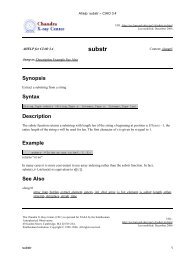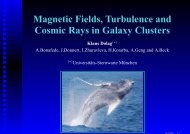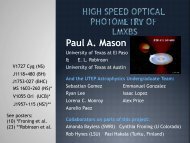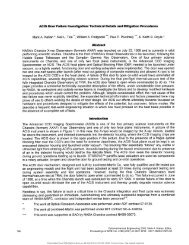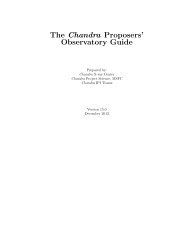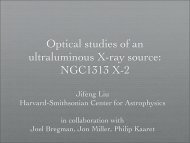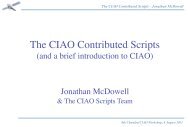Paper Title - Chandra X-Ray Observatory (CXC)
Paper Title - Chandra X-Ray Observatory (CXC)
Paper Title - Chandra X-Ray Observatory (CXC)
Create successful ePaper yourself
Turn your PDF publications into a flip-book with our unique Google optimized e-Paper software.
Fig. 4. Weekly scheduling efficiency. Calculated by diving time spent observing science targets by time available<br />
for observing. Week to week variation largely due to OR list profile. Trends generally due to constraint<br />
migration.<br />
The decline in scheduling ability prompted cross-team analysis and discussion, which led to relaxation of<br />
the EPHIN temperature limits, which, in turn, allowed scheduling ability to recover. This cross-team group<br />
was the precursor to a new working group, the Mission Planning and Constraints Working Group<br />
(MPCWG). The mission of the MPCWG is to minimize the impact of constraints while protecting the<br />
safety of the vehicle. The group has representatives from mission planning, engineering, both SIs and<br />
project management. Since 2005, the group has been actively and effectively managing constraints and<br />
optimizing scheduling, which has kept scheduling efficiency near early mission values.<br />
While it is intuitive that if a constraint is relaxed, scheduling will get easier, it is not simple to discern how<br />
much impact a given relaxation will have. It may be that all of the work put into relaxing a constraint is for<br />
naught, because another constraint overwhelms scheduling in that part of the constraint space. To resolve<br />
this problem, the MPCWG developed a tool that can run all of the models used in scheduling and display<br />
the impact of constraint changes. Given a set of constraints and starting conditions, the tool generates a<br />
maximum allowed dwell time at every attitude in the sky. The user can set constraint thresholds, model<br />
parameters or output dates and regenerate maximum dwell times. Maximum dwell time correlates well to<br />
scheduling efficiency and target availability, since shorter allowed dwells forces splitting long observations<br />
into parts, which decreases target availability, and requires more maneuvering, which reduces efficiency.<br />
So measuring maximum allowed dwell time gives insight into scheduling ability, and generating a delta<br />
chart allows the user to see the impact of a constraint change. The tool can analyze the impact of given<br />
constraint over time, of a constraint relaxation or of a new constraint. This constraint integration tool has<br />
been fully incorporated into the <strong>Chandra</strong> constraint management process and is used to assess the impact of<br />
constraints over time and inform decisions regarding constraint relaxation versus scheduling efficiency. It<br />
also provides dwell time data that is now fed into the process of laying out the yearly observing plan. This<br />
predictive data maximizes the probability that all of the observations chosen for a given week will be able<br />
to be scheduled once that week arrives. Fig. 5 provides a sample output from the constraint integration<br />
routine.



